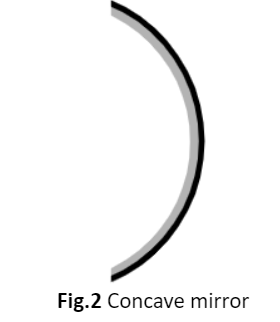Introduction to Mirrors
Introduction to Mirrors
This lesson aligns with NGSS PS4.B
Introduction
Take a look at the letters displayed on the front of the ambulance. Do you observe anything strange about them? You may notice that some of the letters appear to be in reverse, and they don't seem to form a coherent word at first glance. However, these letters are intentionally arranged to spell the word "AMBULANCE" when seen in a mirror. This phenomenon occurs because images in mirrors are flipped horizontally, meaning they are reversed from left to right. The word "ambulance" is spelled in this manner so that individuals driving cars can easily read it when they encounter the ambulance in their rearview mirror. In this article, we will learn about mirrors, the types of mirrors, and how mirrors work.
What is a Mirror?
A mirror is a smooth, reflective surface that can produce a clear image of objects placed in front of it. The key to a mirror's magic lies in its reflective property, which allows it to bounce back light in a way that we can see as an image.
Types of Mirrors
Mirrors come in various types, and each type has unique properties and applications. The two most common types are:
1. Plane Mirrors
Plane mirrors, also known as flat mirrors, are the ones we encounter most frequently in our daily lives. They have a flat, reflective surface, and when you look into one, you see a reflection that appears to be the same size as the object and is located behind the mirror. Plane mirrors produce virtual images, which means that the reflected image cannot be projected onto a screen.

One interesting property of plane mirrors is that they do not change the orientation of the image. If you raise your right hand while looking into a plane mirror, your reflection will also raise its right hand, creating a sense of familiarity.
2. Curved Mirrors
Curved mirrors are more complex than plane mirrors and come in two main types:
a. Concave Mirrors
Concave mirrors are curved inward, like the inner surface of a sphere. These mirrors can either be converging or diverging, depending on their shape. When we say "converging," we mean that the mirror focuses parallel rays of light to a point (the focal point), whereas "diverging" means that it spreads them apart.

b. Convex Mirrors
Convex mirrors are curved outward, away from the observer. They are curved in a way that they always diverge parallel rays of light. When you look at your reflection in a convex mirror, you'll notice that it appears smaller and farther away than it is. This property is useful in wide-angle mirrors often found in vehicles to provide a broader field of view.

How Do Mirrors Work?
Mirrors work based on the principle of reflection. When light falls onto a mirror, it interacts with the smooth surface. This interaction causes the light to bounce back, creating an image that we see as a reflection. The angle at which the incoming light strikes the mirror (known as the angle of incidence) is equal to the angle at which the light reflects off the mirror (known as the angle of reflection). This is known as the law of reflection.
Applications of Mirrors
Mirrors have a wide range of applications in various fields. Here are some common uses:
1. Personal Grooming
One of the most common uses of mirrors is for personal grooming and checking one's appearance.
2. Rearview Mirrors in Vehicles
Convex mirrors are used in rearview mirrors in vehicles. They provide a wider field of view, allowing drivers to see more of what's behind them and reducing blind spots.
3. Reflecting Telescopes
Many astronomical telescopes, such as the Hubble Space Telescope, use mirrors to gather and focus light from distant celestial objects. The large mirrors in these telescopes help capture detailed images of stars, galaxies, and other astronomical phenomena.
4. Microscopes
Microscopes use mirrors to direct and focus light on the specimen being observed.
6. Entertainment and Art
Mirrors are often used in magic tricks and illusions, creating the illusion of objects appearing or disappearing.
Summary
- A mirror is a smooth, reflective surface that can produce a clear image of objects placed in front of it.
- Plane mirrors have a flat, reflective surface, and when you look into one, you see a reflection that appears to be the same size as the object and is located behind the mirror.
- Concave mirrors are curved inward, like the inner surface of a sphere. These mirrors can either be converging or diverging, depending on their shape.
- Convex mirrors are curved outward, away from the observer. They are curved in a way that they always diverge parallel rays of light.
Related Worksheets:













